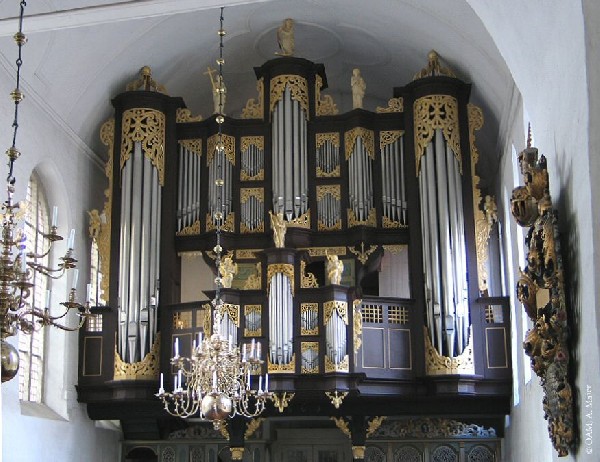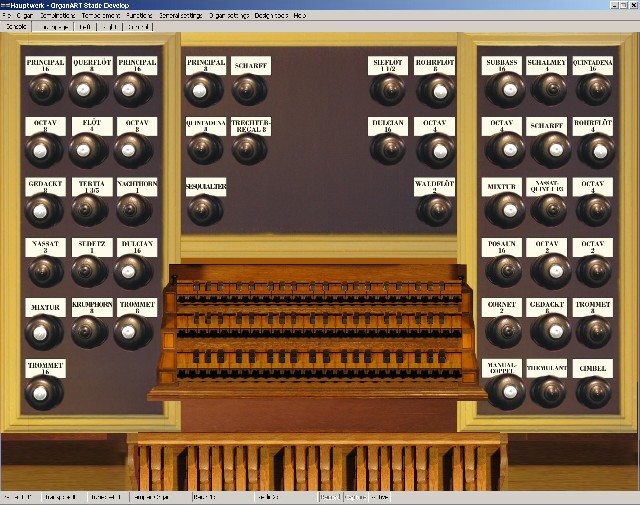Login

1675/88 Hus/Arp Schnitger, Stade, Germany [Back to Library]

| Producer: | OrganArt Media |
| Builder: | Schnitger |
| Country: | Germany |
| Style: | Baroque Organs |
| Manuals: | 3 |
| Pedalboard: | Yes |
| Audio Ouput: | Stereo |
| Software(s): | |
| Date Built: | 1675 |
Description: |
The Hus-Schnitger organ in the St. Cosmae church in Stade, Lower Saxony, with its three manuals and 42 speaking stops on a 16 foot basis is one of the most important large North-German Baroque organs of this day. This organ gives an insight into the North-German organ culture of the 16th and 17th century and offers an authentic representation of organ compositions from this period. The instrument has an exceptionally large number of original pipes. Most reed ranks are original. The first organist in 1675 was Vincent Lübeck who worked here for 30 years. In 1666 Arp Schnitger entered the employment of his uncle Hus at the age of 18. In 1670, at the age of 22, Arp Schnitger officially became his uncle’s journeyman. The uncommonly high salary shows how highly Arp Schnitger was esteemed and the importance of his role in the organ building trade. The organ for Stade was built in several steps. A contract for the complete organ does not exist. In 1670 the bellows and the Hauptwerk (called Oberwerk) with double spring chests were completed and a start was made with the Rückpositiv. The organ front of the Hus-Schnitger organ shows the typical style of the “Hamburger Prospekt” , with Pedal, Hauptwerk, Brustwerk and Rückpositiv divisions. The organ was finally completed in 1675. The instrument had 42 speaking stops and was tuned a whole tone higher than normal. Arp Schnitger was lauded with a gratification for his valuable labour. It is likely that Lübeck urged Schnitger to build four new stops for the organ in 1688: A Trommet 16, Cimbel for the Hauptwerk, a Krumphorn 8 and Schalmey 4 for the Brustwerk. Various changes were made in the centuries that followed. A systematic restoration by Jürgen Ahrend of Loga including a reconstruction of the original organ loft took place in 1972-75. Additional repairs by Jürgen Ahrend were carried out 1993-94. A new paint job of the organ case based on a modern analysis of the historical substance followed in 2008. The organ clearly carries the signature of both organ builders. While the Hauptwerk contains double spring chests, the Rückpositiv, Brustwerk and Pedal contain slider chests. The pipework has different characteristics than other existing Hus organs. The late Renaissance/early Baroque pipework and voicing of Hus produced a mild sound while that of Schnitger a much clearer, brighter and sharper sound, especially in the Mixtures, as is characteristic of the St. Cosmae organ. The reed stops blend well with the other stops as well. This shows that Arp Schnitger clearly had a large influence on the building of this organ. The Hus-Schnitger organ is currently one of the most important large North German baroque organs and is the venue for many concerts, organists, organ study trips as well as workshops and was the foundation of Arp Schnitger’s exemplary career. |
| # of uploads with organ: | 444 |
| # of users uploaded using organ: | 26 |
| Popular Uploads: |
Komm, Gott Schoepfer, heiliger Geist BWV 667 (MIDI file included) (Popup Player) |
| Website: | https://www.organartmedia.com/en/hus-arp-schnitger |
Comments/Reviews
Have we missed some information regarding a sample set? Let us know using our Contact Page. We would greatly appreciate it!

